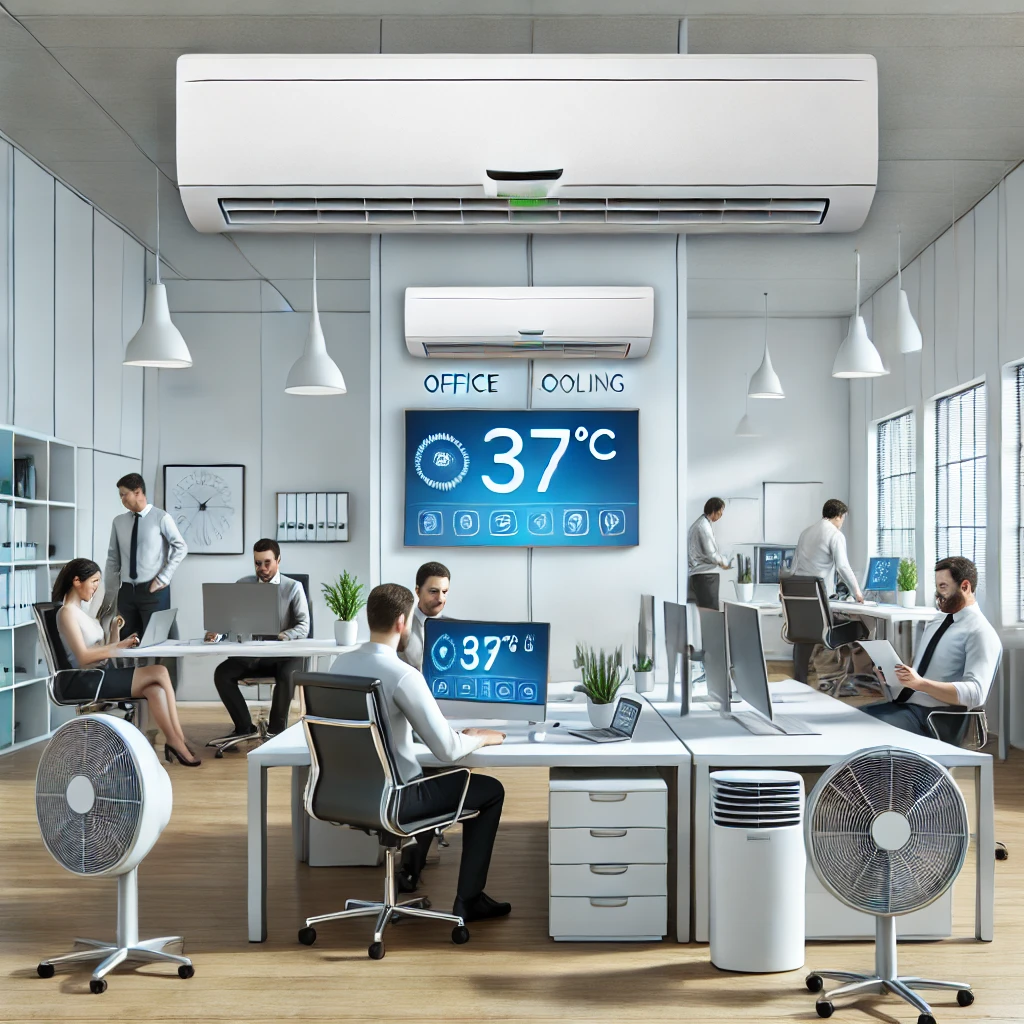Imagine walking into your office on a hot summer day. The air is thick and stifling, making it hard to focus on your tasks. If you’ve ever experienced this, you know how crucial it is to maintain a comfortable office temperature. Not only does it affect your comfort, but it also significantly impacts productivity and health.
In this blog post, we’ll explore the importance of keeping your office cool, the ideal temperature range, and how you can achieve it. We’ll discuss practical tips, eco-friendly solutions, and essential items to ensure your team stays cool and productive all year round.
Understanding the Ideal Office Temperature Range
Before we dive into the specifics of cooling your office, it’s essential to understand what constitutes an ideal office temperature. The right temperature can vary depending on several factors, including the size of the office, the number of people, and the type of work being performed.
The Optimal Temperature
Studies suggest that the ideal temperature for office environments ranges between 68°F and 76°F (20°C to 24°C). This range helps maintain comfort while promoting productivity. It’s important to note that individual preferences may vary, and some employees might feel comfortable at slightly different temperatures.
Balancing Comfort and Productivity
Finding the perfect balance between comfort and productivity can be challenging. While a cooler office can help prevent fatigue and improve focus, excessively low temperatures might lead to discomfort. Conversely, a warmer office can make employees feel sluggish and less motivated. Striking the right balance ensures a pleasant work environment conducive to high performance.
Seasonal Adjustments
Seasonal changes also play a role in determining the ideal office temperature. During the summer months, slightly lower temperatures may be necessary to counteract the heat, whereas in the winter, a slightly warmer setting might be more appropriate. It’s important to adjust the thermostat according to the season to maintain a consistent level of comfort.
How to Achieve Optimal Office Temperature
Now that we’ve established the ideal office temperature range, let’s explore effective ways to achieve and maintain it.
Utilizing Smart Thermostats
Smart thermostats are a game-changer when it comes to office cooling. These devices allow you to set and control the temperature remotely, ensuring a comfortable environment at all times. With advanced features like scheduling and learning algorithms, smart thermostats can adapt to the office’s needs, promoting energy efficiency and cost savings.
Strategic Placement of Fans and Air Conditioners
Fans and air conditioners play a crucial role in maintaining optimal office temperature. Strategically placing fans can help circulate air and create a cooling breeze, especially in larger spaces. Additionally, installing window AC units can provide targeted cooling to specific areas, ensuring every corner of the office remains comfortable.
Designing for Natural Cooling
Designing your office space with natural cooling in mind can make a significant difference. Incorporating elements like larger windows for ventilation, using light-colored curtains to reflect heat, and arranging furniture to maximize airflow help create a naturally cooler environment. These design choices not only enhance comfort but also reduce the reliance on artificial cooling methods.
The Impact of Office Temperature on Employee Productivity and Health
Maintaining the right office temperature goes beyond comfort; it directly affects employee productivity and health.
Studies and Statistics
Numerous studies have highlighted the correlation between office temperature and productivity. According to research, a comfortable temperature can lead to a 10-15% increase in productivity. Conversely, an uncomfortable environment can result in higher error rates and decreased work efficiency.
Common Issues and Solutions
Temperature-related issues in the office can manifest in various ways. Employees might experience discomfort, fatigue, and even health problems due to extreme temperatures. Common issues include headaches, dehydration, and difficulty concentrating. Implementing solutions such as providing hydration stations, encouraging short breaks, and ensuring proper ventilation can mitigate these problems.
Mental Health Considerations
Beyond physical health, office temperature also impacts mental well-being. Uncomfortable temperatures can contribute to stress and irritability, affecting overall mood and morale. By prioritizing a comfortable temperature, employers can foster a positive and conducive work environment.
Office Cooling Essentials Checklist
To maintain a cool office environment, certain essentials are necessary. Here’s a checklist to ensure you have everything you need.
Must-Have Items for Maintaining a Cool Office Environment
- Smart Thermostat: Invest in a reliable smart thermostat to regulate and monitor the office temperature efficiently.
- Window AC Unit: Installing a window AC unit is a practical solution for localized cooling, especially in smaller office spaces.
- Fans: Place fans strategically to enhance air circulation and create a comfortable breeze.
- Hydration Stations: Ensure employees have access to water coolers or hydration stations to stay hydrated throughout the day.
- Light-Colored Curtains: Use light-colored curtains to reflect heat and keep the office cooler.
- Ventilation: Ensure proper ventilation by keeping windows open or using exhaust fans to expel hot air.
- Portable Air Conditioners: Consider portable air conditioners for additional cooling in specific areas.
- Insulation: Properly insulate the office to prevent heat from seeping in during summer and escaping during winter.
- Temperature Sensors: Install temperature sensors to monitor different areas of the office and adjust accordingly.
- Greenery: Incorporate plants to improve air quality and create a cooler ambiance.
Creating a Cooling Plan
Having a plan in place is essential for maintaining a consistently cool office. Regular maintenance of cooling equipment, setting temperature schedules, and addressing any temperature-related complaints promptly can make a significant difference. Ensure that employees are aware of the cooling plan and encourage them to provide feedback for continuous improvement.
Eco-Friendly Cooling Solutions for the Workplace
As businesses strive for sustainability, eco-friendly cooling solutions are gaining prominence. Implementing green cooling practices benefits both the environment and the bottom line.
Benefits of Sustainable Cooling Practices
Sustainable cooling practices reduce energy consumption, lower utility bills, and decrease the carbon footprint. By adopting eco-friendly cooling solutions, businesses demonstrate their commitment to environmental responsibility, which can enhance their reputation and attract environmentally conscious clients and employees.
Implementing Green Cooling Strategies
- Energy-Efficient Appliances: Invest in energy-efficient air conditioners, fans, and other cooling equipment. Look for appliances with high Energy Star ratings to ensure optimal performance with minimal energy consumption.
- Solar Panels: Consider installing solar panels to power cooling systems. Solar energy is a renewable resource that can significantly reduce electricity costs.
- Natural Ventilation: Maximize natural ventilation by designing the office layout to take advantage of cross-ventilation. Open windows strategically to promote airflow and reduce the need for artificial cooling.
- Green Roofs: Implement green roofs with vegetation to provide natural insulation and reduce heat absorption.
- Shade Structures: Install shade structures like awnings or pergolas to block direct sunlight and keep indoor spaces cooler.
Encouraging Employee Participation
Engage employees in the company’s eco-friendly cooling efforts. Educate them about the benefits of sustainable practices and encourage them to adopt energy-saving habits. Small actions, such as turning off unused lights and equipment, can collectively make a significant impact.
Conclusion
Maintaining an optimal office temperature is essential for fostering productivity, health, and overall employee satisfaction. By understanding the ideal temperature range, implementing effective cooling strategies, and embracing eco-friendly solutions, businesses can create a refreshing and comfortable work environment.
Read More Articles: Businessexchanged.com










Comments are closed